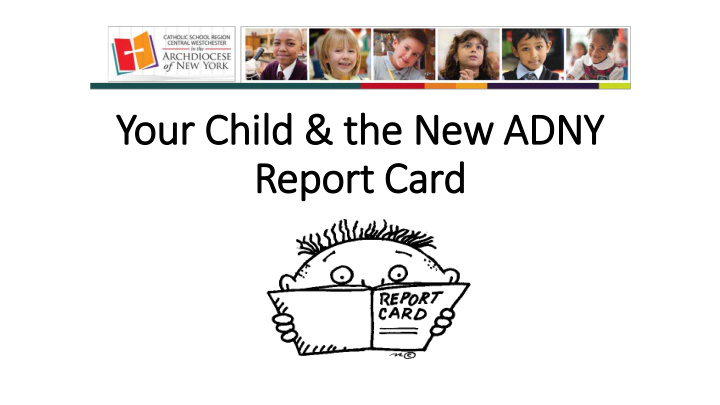



Your Child & the New ADNY Report Card
Purpose • The new, standards-based ADNY Report Card is a tool that was developed to communicate specifically, clearly, and in a timely fashion about each child’s growth. • You will notice the Report Card has Progress Codes. • These Progress Codes are indicators of each student’s growth toward meeting grade-level standards. The new ADNY Report Card aligns nicely with our schools’ ongoing commitment to constantly monitor students’ growth and provide appropriate scaffolding .
Let’s look at the new report card. • Page 1 reflects the former report card. It specifically lists: • Academic Achievement in Core Subjects • Religion • English • Science • Social Studies • Math • Foreign Language • Academic Achievement in Special Subjects • Foreign Language (less than 120 minutes) • Music • Art • Physical Education • General Effort, Conduct, Attendance Page 1 is the page that is sent to high schools, used as transcripts, etc.
Report Card Page 2 • Page 2 allows us to communicate specifically, clearly, and in a timely fashion about each child’s growth. • It allows all of us — students, parents, teachers, and administrators to clearly understand each student’s strengths, as well as areas of concern that require additional support. • Each content area (ELA, Math, Social Studies, and Science) has groups of standards listed. • These standards are a “collapsed” version of the New York State Standards. • For example, in ELA, “Demonstrates an understanding of key ideas and details” is actually RL.5.1, RL.5.2, and RL. 5.3. • Progress Codes are indicated beneath each ”collapsed” standard. • Please note that not all standards are assessed every quarter. • By the end of the school year, it is expected that all standards will be taught and assessed.
Progress Codes • Progress Codes are more specific information regarding a student’s progress on the grade-level standards for each quarter. • The teachers use multiple pieces of evidence to determine a student’s growth. • Evidence includes: • Teacher Observations • Conferencing with students • Student Work Samples • Projects • Tests • Quizzes • Exams The Progress Codes will be noted on the Report Card beginning with the January, 2017 Report Card.
What Do the Progress Codes Mean? • Level 1 — Below Standards • Student demonstrates minimal understanding and seldom meets requirements for grade-level work . Student requires additional instruction, assistance, practice. • Level 2 — Approaching Standards • Student demonstrates partial understanding and is beginning to meet requirement for grade-level work. Student requires some additional instruction, assistance, practice. • Level 3 — Meeting Standards • Student demonstrates and applies knowledge and understanding of learned concepts and skills. The student is proficient and achieves mastery . Student completes work independently. • Level 4 — Exceeding Standards • Student demonstrates and applies knowledge and understanding of learned concepts and skills that exceed requirements for proficiency and mastery. Student consistently applies and extends learned concepts and skills independently.
How do we determine the difference between a 3 and a 4? • A middle school Social Studies teacher posed the following question and asked his/her students to develop a short response: “Describe the conditions in the South following the Civil War and how this affected the nation overall. Address social, geographic, political, and economic conditions.”
Two Students’ Short Responses 3 — Meets Standards 4 — Exceeds Standards “After the Civil War, the South needed to be “In the south most of the cities and completely rebuilt. Due to Total War, their everything in them was completely cities were left in ruins, their farmland was destroyed because of the north’s total destroyed, and roads were also ruined. This war. This made most people living in is only physical destruction. Without the south jobless and homeless. Also slavery, the Southern economy and way of life needed to be changed. Former slaves there was a famine because the north needed jobs, homes, and rights. Plantation had destroyed almost all the food and owners needed to pay workers for their supplies of the south. One last thing is time. This caused hostile relations between it made the south mad which led to both the North and the South. Even though the war was over, there was still a long way things like the KKK and Jim Crow Laws.” to go before life returned to normal.”
How Can Parents Nurture Students’ Growth? • On our ADNY website, BuildBoldFutures.org, Parent Matrices are available for every grade level in ELA & Math. • The Matrices provide: • An explanation of what every standard means. • What parents can do at home to practice with their children. • Hyperlinks to resources. • BuildBoldFutures.org • To access this valuable resource yourself, simply • Go to BuildBoldFutures.org • Click on the Elementary School Tab • Click on Resources for Parents • You will see Parent Matrices
What about th the Early Childhood Developmental Summary? • The standards-based Early Childhood Developmental Summary for PreK3, PreK4, and Kindergarten was developed with the following key points in mind: • Very young children experience growth at different rates. • They are in a new environment; each child adjusts in his/her own timeframe. • They are learning social skills, how to be a member of our school community and a classroom community, as well as academic skills. • Early childhood is a time of rapid growth for students. • Development is not linear. • Level 4 is rare in this age group. The new Early Childhood ADNY Developmental Summary aligns nicely with our schools’ ongoing commitment to constantly monitor students’ growth and provide appropriate scaffolding .
Thank You! Every day, we work together to ensure your child receives the finest Catholic education possible. Thank you so much for taking the time to come and meet with us tonight. Thank you for entrusting your child’s education to us.
Recommend
More recommend